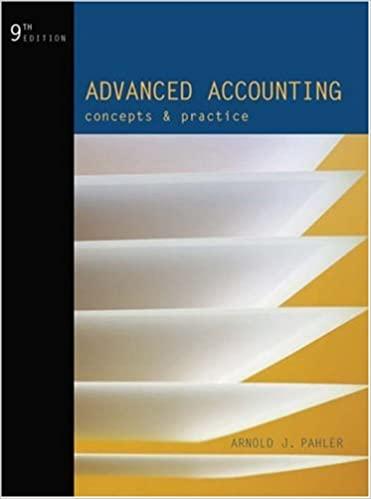Evaluating the Profitability of the Parents Investment PTA Inc. acquired 80% of Scoole Inc.s out standing common
Question:
Evaluating the Profitability of the Parent’s Investment PTA Inc. acquired 80% of Scoole Inc.’s out¬
standing common stock on 1/1/04 for $400,000 cash. Selected financial information follows:
PTA Scoole Year Amortization of Cost in Excess of Book Value Income Reported (Loss) Net Dividends Declared 2004 $20,000 $150,000 2005 20,000 275,000
$125,000 2006 20,000 100,000 200,000 2007 10,000 (75,000) -0-
Additional Information 1. The decision to acquire Scoole was based on cash flow projections, which showed an estimated internal rate of return of approximately 30%.
2. Of the $400,000 purchase price, $150,000 was assigned to goodwill having a 15-year life,
$20,000 to land, and $30,000 to depreciable assets having a remaining life of three years.
(Scoole had a book value of $250,000 on 1/1/04.) Contrary to FAS 142, you are to assume that GAAP requires goodwill to be amortized.
3. PTA chose to use
(a) «o«-push-down accounting and
(b) the equity method.
4. Scoole’s reported net income or loss amounts occurred evenly throughout the year.
5. Scoole declared and paid its dividends on December 20 of each year.
6. In early 2007, Scoole’s major competitor announced a startling patented improvement to its main product, placing Scoole at a major competitive disadvantage.
7. On 12/31/07, PTA (in light of its assessment that Scoole would be only marginally profitable in the future because of the competitor’s improvement) sold its entire interest in Scoole for
$288,640 cash. Just prior to this sale, the market price of Scoole’s common stock was approx¬
imately 7% below the book value of Scoole’s common stock.
1. Prepare a T-account analysis of the Investment in Subsidiary account over the life of the in¬ vestment.
2. Prepare PTA’s entry to record the sale of Scoole.
3. What amounts should be reported in PTA’s 2007 income statement relating to Scoole?
4. Calculate the annual return on PTA’s investment (AROI) for each year.
5. Is it correct to use the begmning-of-year investment balance or the average investment balance for the year in the denominator in requirement 4? Why?
6. Repeat requirement 4 for 2005 under each of the following changed assumptions concerning the $125,000 of dividends declared in 2005:
Assumption Date Declared and Paid A 1/1/05 B 7/1/05 7. Calculate the internal rate of return (IRR) over the life of the investment. State your answer to the nearest whole percent, for example, 15%.
Spreadsheet Integration: You may easily obtain this answer using the IRR function available in EXCEL. You merely need to set up a cash flow table and then program the IRR function.
8. Repeat requirement 7 under each of the following changed assumptions concerning the $125,000 of dividends declared in 2005:
Assumption Date Declared Date Paid A 12/20/05 1/3/06 B 1/1/05 1/5/05 C 6/25/05 7/1/05 9. Prepare a T-account analysis of the Investment account by year over the life of the investment using
(a) the dividend information provided and
(b) the net income amounts assumed under the IRR method. (Use the percentage you calculated in requirement 7 to calculate each year’s assumed net income.)
10. Compare the AROI calculations in requirement 4 with the IRR calculation in requirement 7.
Which is best suited for evaluating the profitability on this investment? Why?
11. If Scoole had been sold on 1/3/08 (instead of 12/31/07), would PTA’s AROI for 2007 be any different? Why or why not?
Step by Step Answer:






